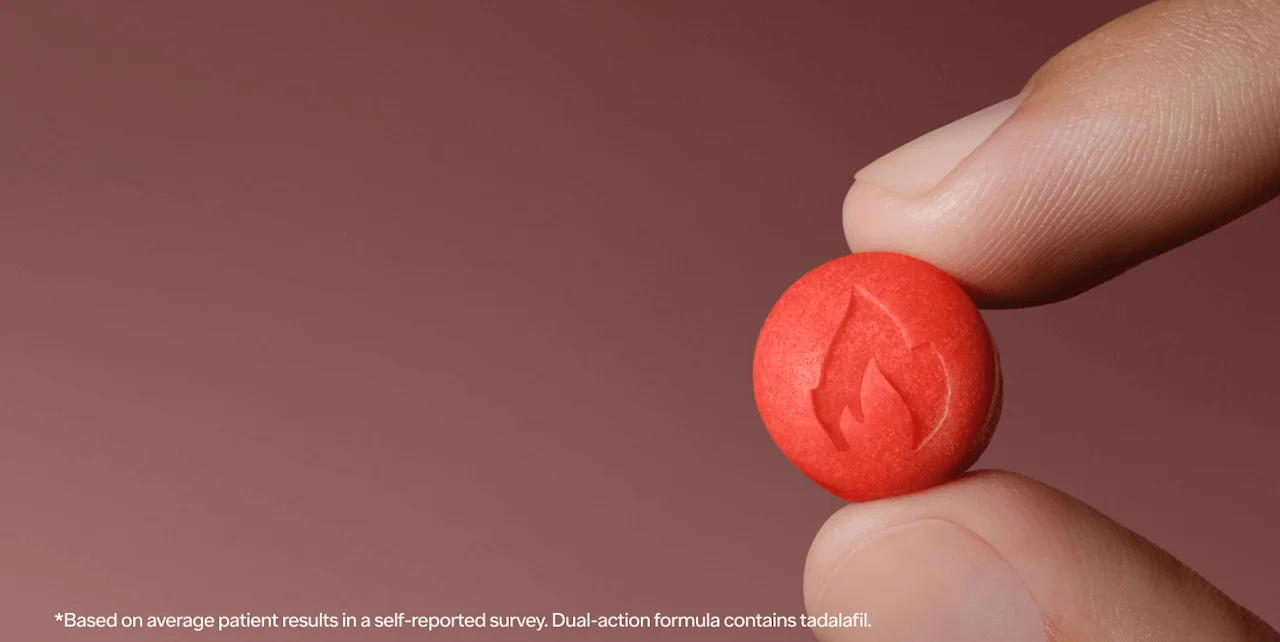Here's what we'll cover
Condom-associated erectile problems (CAEP) is a fancy term for having trouble getting hard or staying hard when wearing a condom.
If you’ve experienced this before, know that you’re not alone. Studies in young men found that roughly nearly 40% experience difficulty achieving or maintaining an erection when using condoms (Crosby, 2002; Graham, 2006).
And while erectile dysfunction (ED) is common, the cause is not always the same. For some people, the issue is the actual condom. Condoms that don’t fit properly can make it difficult to get an erection or keep one.
Anxiety around sexual performance is also a common cause of erectile problems. Some cases of ED can be directly tied to putting on a condom, while others could be a sign of an underlying medical condition.
Luckily, there are strategies to identify the source of the issue and steps you can take to take care of it.
Make sure your condoms are the right size
If they’re too big or too small, condoms can mess with your ability to get or keep an erection. You need one that fits just right.
Condom length is relatively standard across different sizes––it’s the width or girth that changes from one size to the next. Condoms should be tight but never painful.
If you tug on the tip of a condom after you put it on and it starts to slide off, you might want to size down. When a condom is too large, it can interfere with stimulation, making it more difficult to get and stay hard. There are plenty of slim and snug fit brands available that you can try out during some solo play to make sure it fits right.
Condoms that are too small can cut off circulation and make it difficult for blood to enter the penis. This affects the ability to create and maintain an erection.
However, some people find that condoms act like penis rings (also known as cock rings). If a condom is a little tighter than normal, it prevents blood from leaving the penis, which helps you stay harder for longer. That means putting a condom on after you’re already completely hard.
Putting on a tight condom at the beginning of sex or during foreplay can make it difficult for blood to enter the penis, so finding a balance of condom size and the timing to put it on are key.
Once you find a brand or size that you like, make sure to have a pack ready on deck. This can help alleviate any stress around the issue while ensuring you stay safe from sexually transmitted infections and avoid unwanted pregnancy.
Make sure you know how to put on a condom
It might seem silly, but if you’re putting the condom on wrong, that might be the problem.
Luckily, we live in a world where you can learn anything from how to replace a garbage disposal to how to change a tire online. Here are the basic steps of how to put on a condom properly:
Make sure the condom is facing the right direction. It should unroll easily. If it doesn’t, check it again.
If you have a foreskin, make sure to retract it when you put on the condom. If you forget this step, sensations will be significantly reduced during sex, making it more difficult to stay hard.
Make sure to pinch the tip of the condom when you put it on to ensure it doesn’t have air in the reservoir. The tip is meant to catch the semen when you ejaculate, and if it’s filled with air, it can increase the chance of the condom breaking during sex.
Next, unroll the condom from the tip down the shaft of your penis. If it doesn’t unroll easily, check to make sure that it’s facing the right direction.
Some people say that condoms might make sex less enjoyable, but in reality, condoms can actually enhance pleasure for your partner. Look for dotted, ribbed, or other sensation-enhancing condoms to try out and see what you both like. Putting on the condom together can maintain the mood and make it easier to keep an erection.
Find ways to alleviate stress
Sex is a lot about how you’re feeling. Chemicals regulate every process in our body, and sometimes those chemicals can interfere with each other. This can affect everything from forming thoughts to achieving an erection.
Anxiety is an emotion associated with our fight-or-flight response, which is a set of processes our bodies go through when we’re facing a threat. Sex shouldn’t be a threat, but plenty of things can make a person feel uncomfortable when it comes to getting intimate. These thoughts can then interfere with your ability to get or maintain an erection.
If you’ve experienced trouble getting hard with condoms in the past, it can be difficult to psych yourself up to use them again.
It’s also common to stress about sex, particularly if you’re with a new partner. Many people worry that they won’t be able to get an erection or that they’ll ejaculate too quickly. They can be concerned about whether their partner or partners are enjoying themselves. All that stress can play interference, and using condoms can exacerbate these issues.
Here’s some advice if your partner is experiencing CAEP: try to be patient.
It’s important that your partner knows they can take their time and not feel pressured while putting on the condom. If it takes two, three, or even five attempts to make it work, so be it. By showing patience and empathy, you can help alleviate performance anxiety and stress for your partner.
If stress truly is contributing to your CAEP, there are steps you can take to improve it.
Therapy
In the age of telehealth, there’s no shortage of outlets and apps you can use to get in touch with a therapist or other mental health professional to discuss what’s weighing on you.
You can also explore in-person talk therapy on your own or as a couple. A therapist can help you identify alternative outlets for your stress and resolve any underlying conflicts that might be affecting your sex life.
Exercise
In addition to improving heart health, regular exercise is a great way to relieve stress. And of course, achieving an erection is a lot easier when your body is healthy and you feel stress-free.
Yoga, meditation, and acupuncture have also been shown to improve mood. While not scientifically proven to treat CAEP, these types of therapies might help.
Lifestyle changes
Your erections will be best when your physical health is good. Making simple lifestyle changes—such as exercising, eating a healthy diet, quitting smoking, and limiting alcohol consumption—might be enough to improve ED.
Tips for getting back on track
Taking care of any erectile problems you experience is important.
People who have difficulty getting hard when using condoms might be less less likely to use condoms and more likely to have unprotected sex, which can increase the risk of STIs or unwanted pregnancies (Graham, 2006).
If you have CAEP or anxiety about condoms in general, here are some tips to get yourself better acquainted:
Practice putting the condom on by yourself without a partner. Masturbate with a condom on and explore ways you can feel pleasure while wearing it. For some people this can help get rid of any negative associations with condoms.
Put a small amount of water or silicone-based lube on your penis before putting on the condom. Don’t put on too much or the condom can slip off. Never use oil-based lube as it can damage the condom.
Some people find that medications like sildenafil (brand name Viagra), tadalafil (brand name Cialis), or vardenafil (brand name Levitra) are effective at increasing their ability to get or maintain an erection. Some of these drugs can be taken just before sex, while others can be taken daily and don’t require planning. These medications work by increasing blood flow to your penis. You can speak with a healthcare provider about picking the one that’s right for you.
Causes of ED
Research has found that many people with CAEP experience ED when they’re not using condoms, too (Sanders, 2015).
Even though ED is super common, it’s not something you should ignore. In addition to messing with your sex life, erectile dysfunction can be a sign of other health conditions like diabetes, high cholesterol, high blood pressure, heart issues, and other serious problems. In some cases identifying and treating the underlying issue can improve ED.
Many medications are known to cause ED. A quick chat with your healthcare provider can allow them to find an alternative that doesn’t come with sexual side effects.
If you or your partner are experiencing condom-associated erectile problems, remember that it’s common and there are many options to troubleshoot the issue.
There’s no better way to protect yourself from sexually transmitted infections and pregnancy during sex, so before you give up on condoms, try experimenting at home or speak with a trusted healthcare provider to explore other options.
DISCLAIMER
If you have any medical questions or concerns, please talk to your healthcare provider. The articles on Health Guide are underpinned by peer-reviewed research and information drawn from medical societies and governmental agencies. However, they are not a substitute for professional medical advice, diagnosis, or treatment.
Viagra Important Safety Information: Read more about serious warnings and safety info.
Cialis Important Safety Information: Read more about serious warnings and safety info.
References
Crosby, R. A., Sanders, S. A., Yarber, W. L., Graham, C. A., & Dodge, B. (2002). Condom use errors and problems among college men. Journal of Sexually Transmitted Diseases, 29 (9), 552–557. doi: 10.1097/00007435-200209000-00010. Retrieved from https://pubmed.ncbi.nlm.nih.gov/12218848/
Graham, C. A., Crosby, R., Yarber, W. L., Sanders, S. A., McBride, K., Milhausen, R. R., & Arno, J. N. (2006). Erection loss in association with condom use among young men attending a public STI clinic: potential correlates and implications for risk behaviour. Journal of Sexual Health, 3 (4), 255–260. doi: 10.1071/sh06026. Retrieved from https://pubmed.ncbi.nlm.nih.gov/17112437/
Sanders, S.A., Hill, B.J., Janssen, E., Graham, C.A., Crosby, R.A., Milhausen, R.R. and Yarber, W.L. (2015), Condom‐Associated Erection Problems. Journal of Sexual Medicine, 12: 1897-1904. DOI: 10.1111/jsm.12964. Retrieved from https://onlinelibrary.wiley.com/doi/abs/10.1111/jsm.12964












